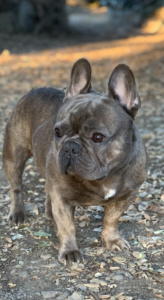Like many purebred dogs, French Bulldogs are prone to specific health problems. This is especially true for Blue French Bulldogs, a color variation that shares the same physical traits as standard Frenchies—short bodies and flat faces, which can make them more susceptible to certain health concerns. Responsible care starts with choosing a trusted breeder and being informed about the potential French Bulldog health issues you may encounter.
Common Health Problems in Blue French Bulldogs
Due to their unique build and genetics, Blue French Bulldog health issues often include respiratory challenges, skin sensitivities, and allergies. Their flat faces can lead to breathing difficulties, especially in hot or humid conditions, while their sensitive skin may react strongly to environmental or dietary triggers.
Allergies in Blue French Bulldogs
One of the most frequent Blue French Bulldog health issues is allergies. These can be caused by food ingredients such as certain meats, nuts, or dairy products, as well as environmental factors like dust or pollen. Allergic reactions can manifest through skin irritation, itching, or digestive problems.
To determine the exact cause, your vet may recommend an intradermal skin test or an elimination diet to identify specific triggers. If your Frenchie is diagnosed with allergies, you’ll likely need to remove certain foods from their diet and keep their environment clean and dust-free.
Proactive Health Management for French Bulldogs
To minimize the impact of common French Bulldog health issues, regular vet visits, a well-managed diet, and a clean living environment are key. Monitor your Blue Frenchie closely and act quickly if symptoms appear. With the right care, they can lead a comfortable and happy life.
Symptoms of allergies in French Bulldogs include:
- Runny nose
- Itchy Skin
- Blistered Skin
- Excessive sneezing
- Tears in the Eyes
- Constant licking and scratching
Hip Dysplasia
Hip dysplasia may happen in Blue French bulldog for a lot of reasons. The reasons can be because of their genetics, obesity, age and other different kinds of physical activity.
Hip dysplasia is a disorder of the hips which makes it difficult for the dog to move around as the legs can come out slightly from the socket of the hip which makes them unable to move around freely. The symptoms include hopping, inability to walk freely, inactivity, clicking sounds from the hips.
The best way to prevent hip dysplasia is to keep a good diet, proper exercise, and joint supplements. In mild cases of hip dysplasia, the dog is given physical therapy and a list of medicines. In severe cases, the vet will recommend hip replacement surgery.
Brachycephalic Syndrome
Blue French bulldogs are a brachycephalic breed. This means that they are a short-faced breed with narrow nostrils and a smushed face. This gives them problems such as breathing as their respiratory tracts will not allow free flow of air in and out of the lungs. Surgeries are required in extreme cases such as soft palates, stenotic nares and everted laryngeal saccules to keep them from suffocating.
Conjunctivitis (Pinkeye)
Conjunctivitis is tissue inflammation of the tissues that cover the outer part of the eyeball. This is commonly referred to as pinkeye. Conjunctivitis can be diagnosed by swollen eyelids, red eyes, liquidy discharge from the eyes and squinting. It can also be caused by dry eyes, allergies, and some serious problems such as canine distemper.
Symptoms of conjunctivitis in French Bulldogs
- Bloodshot eyes
- Swollen Eyelids
- Liquidy Discharge from the eyes
- Squinting
- Rubbing the eyes
Other Conditions
Other health conditions such as cataracts, entropion and, luxating patellas which can make the eyelids turn inside. If your Blue French bulldog shows signs of distress then you need to make sure that you take them to the vet and also do routine checkups to keep them healthy. With the right love and care, French bulldogs can often survive healthily and contentedly for anywhere between 11 and 15 years, or perhaps longer.

